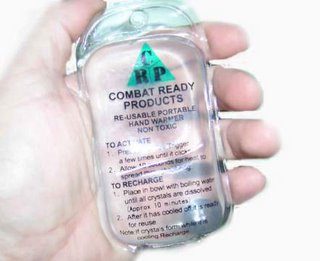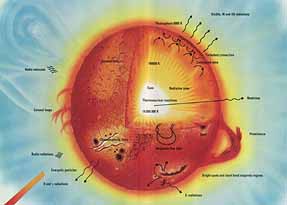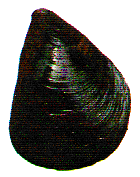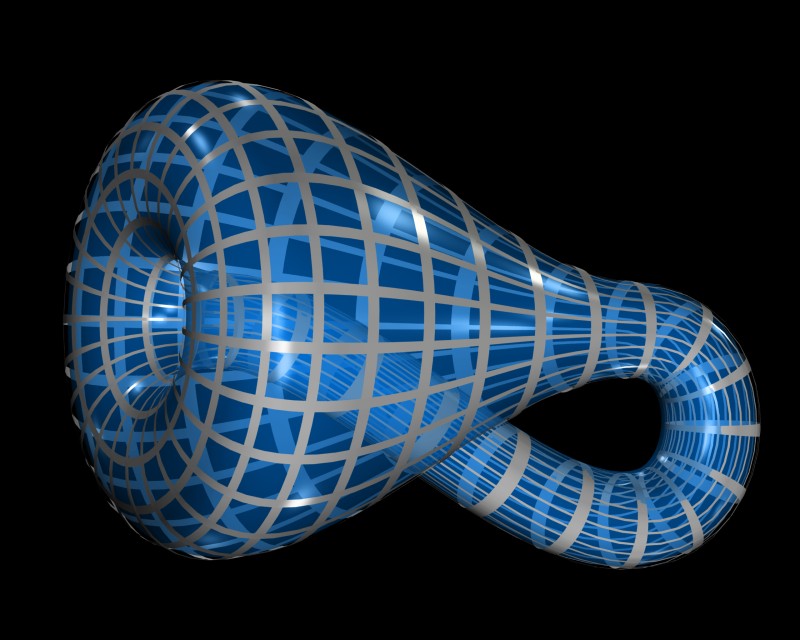Keywords: Supercooling, Hand warmers, Crystallization.
If you hold on to the thread till the end, you might actually learn something. As a teaser: The title is sorta accurate. Read on to find out.
My friend and I went that evening to the sports store to do some ski gear shopping. As we left the store for another to do some price comparison, we entered into a chat with the guy at the counter. He said he was going to buy
ski mittens instead of ski gloves. Minnesota cold meant mittens, which offer additional warmth for fingers (as they are next to each other). Mittens are also convenient for using hand warmers in them (these are heating pads inserted in the back of the gloves for additional warmth).
Hand Warmers: So our discussion turned to reusable hand warmers (see picture. the metal is at the bottom of the pouch). He showed us a small plastic pouch of liquid with a penny sized metal plate inside it. When the metal is bent, the liquid slowly starts to turn solid and white, and releases a lot of heat while solidifying.

The liquid, it turns out, is sodium acetate, which is a very specially suited liquid for use in hand warmers. The process of releasing energy it turns out is due to two other very special processes called supercooling and crystallization. These can be observed by performing experiments which you can do yourself either by buying an handwarmer pouch or even with water (you have to work extra hard for this).
Cooling and Crystallization: Supercooling is the principle that lies at the bottom of this heat release. Cooling, as we know it, is a process by which temperature of a liquid (think
water) is reduced. As the temperature goes down slowly the liquid starts to turn into solid. What is really happening here is that liquid starts to go through a change in phase (from liquid to solid) as the temperature goes down.
In fact you can see that until the temperature reaches zero, the water remains water. No ice. When temperature reaches zero, the process called crystallization starts (nobody really understands how this works). Around an impurity or a surface with irregularities (even smooth surfaces have a small amount of irregularities), the water molecules find the source for some kind of a disturbance to their liquid state. At these crystallization points, water begins to crystallize (that is, becomes ice), right when temperature hits zero. Slowly as crystallization spreads, the surface of the ice thus formed becomes a natural site for further crystallization of the uncrystallized water that remains. Water placed in an ice cube box becomes ice much faster than if kept in a vessel: because the amount of surface irregularities for potential crystallization is larger in the ice box. The temperature at which the liquid crystallizes to solid is called the freezing point temperature. So that is the short primer on cooling and formation of ice for you.
Supercooling: If you cool a liquid very quickly and much below the freezing point temperature, the liquid can avoid crystallization and remain liquid. But, now it remains liquid at a temperature lower than the freezing point temperature. For this process, it is important that as the liquid is cooled it remains still and undisturbed. Even slight disturbances can provide a site for crystallization to start.
Crystallization and Heat: So when this supercooled liquid is disturbed, it immediately begins to crystallize. But then, when it crystallizes its temperature is restored to freezing point temperature. So all this energy that comes from crystallization (called
latent heat) is released outside. If you must know, this kind of reaction where energy is released outside is called
exothermic (exo=out, therma=heat).
Back to Hand Warmers: So this is what is happening with sodium acetate. It is naturally in the liquid form above 54 degC. On cooling, it will freeze at 54 degC. When I found this liquid pouch of sodium acetate at room temperature (25-30 degC), it is liquid at a temperature clearly below its freezing point temperature. But this pack is shaken, transported in trucks and sold in shops. How is it possible? Well, it turns out sodium acetate is special. It is very stable as a supercooled liquid. It needs heat to be supplied to disturb its condition and induce crystallization.
This is precisely the point of the metal piece inside. When the metal piece is bent, it produces a very small amount of heat; Heat that is good enough to make sodium acetate crystallize. Then sodium acetate freezes and restores itself to 54 degC. We find that it is heating up our hand because our outside body temperature is 25-30 degC.
So this is the cool story of how supercooling, crystallization, and sodium acetate come together to make our hands warmer.
Actually there is more unexpected stuff. You will have to wait until next week to find out, and
this time you don't get to choose the liquid, but the metal.
Additional Notes:[1] I never told you why the hand warmers were reusable. So what needs to be done with frozen crystallized sodium acetate is a careful process of boiling and cooling back to room temperature (remember that this is below the freezing point temperature of sodium acetate). So place this pouch in hot water and make sure
every crystal is melted to liquid. Then let it cool without any disturbance. Since sodium acetate is quite stable it will supercool to room temperature nicely. Then you can reuse it by bending the metal plate again. You can do this experiment with water. However, though cooling water below zero degC (say to -2 or -3 degC) is possible, you have be sure that the container remians undisturbed throughout the experiment. And remember, water is
not as stable in the supercooled state as sodium acetate.
Some >links<How
hand warmers work (scroll down),
wiki on hand warmers and
an experiment (.pdf file) with handwarmers. How supercooling might be useful in
metal treatment and hydrogen fuel cells Understanding
exothermic and endothermic reactions from pbs A demonstration of
supercooling in waterTrivia:
[1] During the Korean war (circa 1924), Japanese soldiers mixed warming powder (a mixture of iron, water, cellulose, vermiculite, activated carbon and salt) with water to generate heat to help keep soldiers warm in the bitter cold of the wartime battlefield.
[2] Rusting of Iron produces heat, but the process is so slow that you don't notice it.
« Being on Cloud Nine





